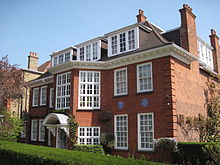Freud Museum
The Freud Museum was the home of Sigmund Freud and his family after they escaped the Nazi takeover of Austria in 1938. It is at 20 Maresfield Gardens in Hampstead, London.
 The exterior of the Freud Museum, London. | |
| Established | 28 July 1986 |
|---|---|
| Location | 20 Maresfield Gardens, London NW3 |
| Public transit access | Finchley Road |
| Website | www.freud.org.uk |
After the death of Anna Freud, the youngest daughter, in 1982, the home became a museum. The centrepiece of the museum is Freud's study, preserved just as it was during his lifetime.
There are two other Freud Museums, one in Vienna, and another in Příbor, the Czech Republic, in the house where Freud was born.
The study
changeThe study and library were preserved by Anna Freud after her father's death. The bookshelf behind Freud's desk contains some of his favourite authors: not only Goethe and Shakespeare but also Heine, Multatuli and Anatole France. Freud acknowledged that poets and philosophers had gained insights into the unconscious which psychoanalysis sought to explain systematically.
The room contains the original analytic couch brought from Berggasse 19. On this patients would recline comfortably while Freud, out of sight in the green tub chair, listened to their 'free association'. They were asked to say everything that came to mind without consciously sifting or selecting information. This method became a foundation upon which psychoanalysis was built.
Antiquities
changeThe study is filled with antiquities from ancient Greece, Rome, Egypt and the Orient. There are some fine masks and carving from Africa. Freud visited many archaeological sites (though not Egypt). Most of the collection was got from dealers in Vienna.
He confessed that his passion for collecting was second only to his addiction to cigars. The importance of the collection can be seen in Freud's use of archaeology as a metaphor for psychoanalysis. One example of this is Freud's explanation to a patient that conscious material 'wears away' while what is unconscious is relatively unchanging: "I illustrated my remarks by pointing to the antique objects about my room. They were, in fact, I said, only objects found in a tomb, and their burial had been their preservation".
The collection includes a portrait of Freud by Salvador Dalí.[1]
References
change- ↑ About the Museum accessed 23 August 2012
Other websites
change- Freud Museum website
- Freud Museum in Vienna Archived 2014-05-30 at the Wayback Machine